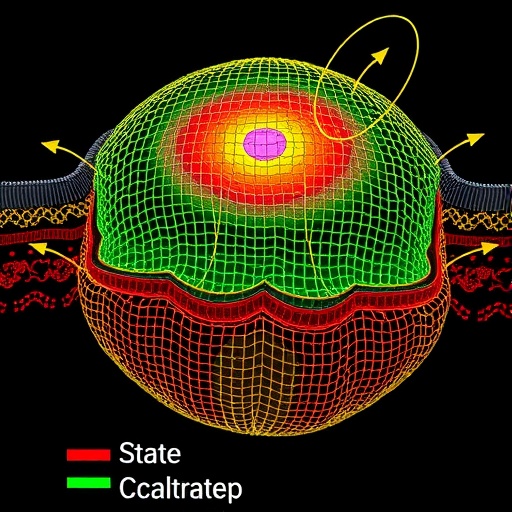In a groundbreaking study set to redefine our understanding of plant endocytosis, researchers have unveiled the intricate molecular architecture and functional mechanics of the TPLATE complex (TPC) in Arabidopsis thaliana. This research, published in Nature Plants, leverages an integrative structural approach combining biochemical techniques and advanced computational modeling to detail how the TPC orchestrates membrane deformation critical for endocytic processes in plants.
Endocytosis, a fundamental cellular process conserved across eukaryotes, is essential for the maintenance of plasma membrane homeostasis. It involves the regulated internalization of membrane lipids and proteins, enabling dynamic adaptation to environmental cues and cellular demands. While the general principle of endocytosis is evolutionarily preserved, the specific protein assemblies mediating this process vary markedly between kingdoms. The TPLATE complex, unique to plants, represents an ancient adaptation—a multifunctional octameric assembly that integrates several protein domains known to facilitate endocytosis, bundled into a singular structural entity.
Despite recognition of the TPC’s pivotal role, its precise molecular conformation and mechanistic modus operandi had remained elusive. Through a meticulous combination of biochemical purification, cryo-electron microscopy (cryo-EM), cross-linking mass spectrometry, and molecular dynamics simulations, the investigative team achieved a high-resolution structural map revealing significant nuances of the TPC’s architecture. This unprecedented detail enabled the visualization of an inherent structural flexibility within the complex, a feature the authors propose as essential for its effectiveness in membrane remodeling.
Interestingly, the TPC is characterized by a crescent-shaped scaffold formed by the structured domains of its constituent proteins. Molecular dynamics simulations conducted as part of the study suggest that this curvature generates bending forces on the membrane independently of cytoskeletal interactions, distinguishing plant endocytosis from its fungal and animal counterparts, where actin polymerization often plays a central role. This discovery implicates TPC as a primary architect in initiating membrane invagination necessary for vesicle formation.
In addition to its overall shape, the study illuminated how different domains within the TPC exhibit specialized lipid-binding preferences, collectively composing a multifaceted membrane-binding interface. This modular lipid recognition allows the complex to selectively engage specific phospholipids in the inner leaflet of the plasma membrane, thus ensuring precise spatial localization and stability during endocytosis. Such specificity may underlie the plant cell’s ability to fine-tune vesicle formation in response to diverse physiological conditions.
The research further underscores the indispensable nature of the identified structural flexibility. Through mutagenesis and functional assays, the investigators demonstrated that constrained or rigidified TPC configurations drastically impair its recruitment to the plasma membrane and subsequent endocytic functionality. This dynamic pliancy likely facilitates conformational adaptations enabling the complex to accommodate and generate membrane curvature, thereby mechanically driving vesicle budding without reliance on external force-generating structures.
Historically, endocytic complexes in other eukaryotes such as clathrin adaptors and BAR domain proteins have been well-studied, with their modes of membrane interaction and force generation partially elucidated. The TPC differentiates itself by merging multiple key protein folds into a single octameric complex, symbolizing an elegant evolutionary solution tuned specifically for plant cellular architecture and physiology. By dissecting this arrangement, the present study fills a vital gap in comparative cell biology.
The integration of computational simulation with experimental biochemistry exemplifies a powerful paradigm in understanding large macromolecular assemblies. The molecular dynamics simulations confirm that the curvature imprinted by the TPC scaffold is not merely a static structural feature but an active driver of membrane remodeling. This finding not only expands the functional repertoire assigned to the complex but also provides a mechanistic framework applicable to other protein assemblies involved in membrane dynamics.
Moreover, this research elegantly reconciles previous observations that plant endocytosis operates efficiently in the absence of strong cytoskeletal contributions. By attributing the driving force to the intrinsic structure and dynamics of the TPC, it challenges prevailing assumptions and opens new avenues for exploring membrane trafficking mechanisms in plant cells, particularly under conditions where cytoskeletal remodeling is limited or modulated.
From a broader perspective, these insights bear significant implications for biotechnology and crop science. Understanding how plant cells regulate membrane turnover and vesicle trafficking can inform strategies to engineer improved nutrient uptake, pathogen resistance, or stress adaptation. Manipulating TPC function or expression might yield novel tools to optimize these processes, impacting agricultural productivity and resilience.
Additionally, the discovery of lipid preference heterogeneity within the TPC suggests potential regulatory checkpoints mediated by membrane composition. This raises fascinating questions regarding how lipidomic profiles influence endocytic initiation and whether this can be externally modulated for strategic benefit. Future studies might probe these regulatory layers to complete the picture of endocytic control in plants.
The study also highlights the evolutionary ingenuity of plants. By consolidating multiple functional protein domains into a single complex capable of independent membrane deformation, plants have evolved a membrane remodeling mechanism with intrinsic mechanical capabilities. This contrasts with the division of labor seen in other kingdoms and underscores the diversity of evolutionary solutions to common cellular challenges.
In conclusion, the combined biochemical and computational study of the TPLATE complex in Arabidopsis not only provides a molecular blueprint for plant endocytosis initiation but also alters our conceptual framework of how membrane trafficking can be driven at a fundamental level. These findings promise to energize further research into plant cellular dynamics, and potentially inspire biomimetic applications leveraging curvature-generating protein scaffolds.
As the field progresses, the integrative high-resolution characterization of protein complexes such as TPC will remain a linchpin for unraveling the complexities of intracellular membrane traffic. This breakthrough sets a new standard for the structural and functional dissection of endocytic machineries and underscores the power of merging experimental and computational methodologies in contemporary cell biology.
Subject of Research: Membrane remodeling and endocytosis mechanism in plants
Article Title: A combined biochemical and computational approach provides evidence for membrane remodelling by the structural scaffold of the endocytic TPLATE complex
Article References:
Kraus, J.M., Neubergerová, M., Cuadrado, A.F. et al. A combined biochemical and computational approach provides evidence for membrane remodelling by the structural scaffold of the endocytic TPLATE complex. Nat. Plants (2025). https://doi.org/10.1038/s41477-025-02146-y
Image Credits: AI Generated




